I haven't provided detailed commentary on the US labour market for a while now. To…
Australian labour market – more than 2 million workers without work – 14.7 per cent
The Australian Bureau of Statistics released the latest labour force data today (November 11, 2021) – Labour Force, Australia – for October 2021. The background is that the entire East Coast has now come out of an extended lockdown over the last few months. The October 2021 data reveals the damage that those lockdowns have caused. But, given that today’s data reflects what was happening about a month ago, it is still too early to say what the speed of recovery will be although more recent payroll data suggests that employment growth is rebounding. But the story of today’s data is that total employment and the unemployment rate are worse than before the pandemic – so the nation has lost ground over the last 20 months. And that is largely because the federal government withdrew its fiscal stimulus too early. The summary results are clear: employment continues to contract, the unemployment and broader underutilisation rates soared. There are nearly 2 million Australian workers without work in one way or another (officially unemployed or underemployed) and several hundred thousand who have left the active labour force due to lack of employment opportunities. Overall, the labour market is in poor shape and the federal government is doing nothing to help. The lack of any significant stimulus from the federal government is telling. There is now definite evidence that further and rather massive fiscal support is required.
The summary ABS Labour Force (seasonally adjusted) estimates for October 2021 are:
- Employment decreased by 46,300 (-0.4 per cent) – Full-time employment decreased by 40.4 thousand and part-time employment decreased by 5.9 thousand.
- Unemployment increased by 81,800 to 707,300 persons.
- The official unemployment rate increased 0.6 points to 5.2 per cent.
- The participation rate rose by 0.1 points to 64.7 per cent.
- The employment-population ratio fell by 0.2 points to 61.3 per cent.
- Aggregate monthly hours worked decreased 1 million hours (0.1 per cent).
- Underemployment increased by 0.3 points to 9.5 per cent (a rise of 40.5 thousand). Overall there are 1,287.4 thousand underemployed workers. The total labour underutilisation rate (unemployment plus underemployment) increased by 0.8 points to a staggering 14.7 per cent. There were a total of 1,994.7 thousand workers either unemployed or underemployed.
Employment decreased by 46,300 in October 2021
Employment fell for the third consecutive month as did the employment-population ratio.
1. Employment growth was -0.4 per cent with 46,300 (net) jobs being scrapped.
2. Full-time employment decreased by 40.4 thousand and part-time employment decreased by 5.9 thousand.
3. Employment in Australia is 160.2 thousand (net) jobs (-1.2 per cent) below the pre-pandemic level in February 2020.
The following graph shows the month by month growth in full-time (blue columns), part-time (grey columns) and total employment (green line) for the 24 months to October 2021 using seasonally adjusted data.
The following table provides an accounting summary of the labour market performance over the last six months to provide a longer perspective that cuts through the monthly variability and provides a better assessment of the trends.
Given the variation in the labour force estimates, it is sometimes useful to examine the Employment-to-Population ratio (%) because the underlying population estimates (denominator) are less cyclical and subject to variation than the labour force estimates. This is an alternative measure of the robustness of activity to the unemployment rate, which is sensitive to those labour force swings.
The following graph shows the Employment-to-Population ratio, since February 2008 (the low-point unemployment rate of the last cycle).
It fell with the onset of the GFC, recovered under the boost provided by the fiscal stimulus packages but then went backwards again as the Federal government imposed fiscal austerity in a hare-brained attempt at achieving a fiscal surplus in 2012.
The ratio fell by 0.2 points in October 2021 to 61.3 per cent.
The last three months have seen this ratio fall sharply by 1.7 points. Quite a fall.
There are two forces working here – the denominator (population) is clearly providing favourable pressures due to the slower population growth as a result of the lack of immigration due to the on-going external border closures.
This is forcing employers to search harder for workers already in Australia rather than discriminate against the unemployed.
The numerator (employment) is clearly weaker as a result of the current lockdowns.
To put the current monthly performance into perspective, the following graph shows the average monthly employment change for the calendar years from 1980 to 2021 (to date).
1. The labour market weakened considerably over 2018 and that situation worsened in 2019.
2. The average employment change over 2020 was -8.4 thousand.
3. So far in 2021, the average monthly change is -3.1 thousand.
The following graph shows the average monthly changes in Full-time and Part-time employment (lower panel) in thousands since 1980.
The interesting result is that during recessions or slow-downs, it is full-time employment that takes the bulk of the adjustment. Even when full-time employment growth is negative, part-time employment usually continues to grow.
However, this crisis is different because much of the employment losses are the result of lockdown and enforced business closures in sectors where part-time employment dominates.
Actual and Trend Employment
The Australian labour market is still some way from catching up on the jobs that were lost during the pandemic. And the situation worsened in October 2021.
The following graph shows total employment (blue line) and what employment would have been if it had continued to grow according to the average growth rate between 2015 and February 2020.
The gap as at October 2021 rose by 71.3 thousand to 652.3 thousand jobs.
This is a good indicator of the extent of damage caused by the pandemic.
Hours worked increased 15 million hours (0.08 per cent) in October 2021
The following graph shows the monthly growth (in per cent) over the last 24 months.
The dark linear line is a simple regression trend of the monthly change – which depicts flat trend.
The Population Slowdown
The following graph shows Australia’s working age population (Over 15 year olds) from January 2015 to October 2021.
With the external border still largely closed, immigration has shrunk to virtually zero and the impact is very clear.
This flattening out has forced employers to work harder to get workers and is one of the reasons unemployment is falling quite quickly, given the circumstances.
State by State Employment Trends
The lockdowns imposed in Sydney, Canberra and Melbourne are now over but they were still in place when this data was being assembled.
The following graphs show the employment evolution since March 2020 by state and territory.
The impact of those lengthy lockdowns in NSW, ACT and Victoria are now clear.
NSW is 5.4 points below where it was in May 2021.
Victoria is 4 points below and tha ACT is 9.3 below its last peak in December 2020.
In general, employment growth has slowed across the nation – even in states without extended lockdowns.
That is because the federal government withdrew much of the fiscal support after March 2021.
Unemployment increased by 81,800 to 707,300 persons
The official unemployment rate rose sharply in October by 0.6 points 5.2 per cent partly because participation rose by 0.1 points but mostly because employment growth was negative.
The following graph shows the national unemployment rate from February 1980 to October 2021. The longer time-series helps frame some perspective to what is happening at present.
Assessment:
1. Official unemployment is now 0.1 points above the pre-pandemic February 2020 level – but we shouldn’t use that as the aspirational benchmark given that the economy was already in bad shape at that point.
2. Further, once we factor in those who have been forced out of the labour force by the dearth of employment opportunities, the situation is much worse. The participation rate is 1.2 points below the February 2020 level, which is about 254 thousand workers. If we add that back into the unemployed we would have an unemployment rate of around 7 per cent.
2. The usual cyclical asymmetry where unemployment rises quickly and falls very slowly is not being observed this cycle because of the population growth slowdown.
2. There is still considerable slack in the labour market that could be absorbed with further fiscal stimulus.
Broad labour underutilisation increased by a staggering 0.8 points to 14.7 per cent in October 2021
The results for October 2021 are (seasonally adjusted):
1. Underemployment increased by 0.3 points to 9.5 per cent (a rise of 40.5 thousand)
2. Overall there are 1,287.4 thousand underemployed workers.
3. The total labour underutilisation rate (unemployment plus underemployment) increased by 0.8 points to a staggering 14.7 per cent.
4. There were a total of 1,994.7 thousand workers either unemployed or underemployed.
The following graph plots the seasonally-adjusted underemployment rate in Australia from February 1980 to the October 2021 (blue line) and the broad underutilisation rate over the same period (green line).
The difference between the two lines is the unemployment rate.
The three cyclical peaks correspond to the 1982, 1991 recessions and the more recent downturn.
The other difference between now and the two earlier cycles is that the recovery triggered by the fiscal stimulus in 2008-09 did not persist and as soon as the ‘fiscal surplus’ fetish kicked in in 2012, things went backwards very quickly.
The two earlier peaks were sharp but steadily declined. The last peak fell away on the back of the stimulus but turned again when the stimulus was withdrawn.
Unemployment and broad labour underutilisation indexes – last four downturns
The following graph captures the evolution of the unemployment rates for the 1982, 1991, GFC and COVID-19 downturns.
For each episode, the graph begins at 100 – which is the index value of the unemployment rate at the low-point of each cycle (June 1981; December 1989; February 2008, and February 2020, respectively).
We then plot each episode out for 90 months.
For 1991, the peak unemployment which was achieved some 38 months after the downturn began and the resulting recovery was painfully slow. While the 1982 recession was severe the economy and the labour market was recovering by the 26th month. The pace of recovery for the 1982 once it began was faster than the recovery in the current period.
During the GFC crisis, the unemployment rate peaked after 16 months (thanks to a substantial fiscal stimulus) but then started rising again once the stimulus was prematurely withdrawn and a new peak occurred at the 80th month.
The COVID-19 downturn was obviously worse than any of the previous recessions shown but because of its unique nature – the job losses being largely driven by lockdowns etc.
The graph provides a graphical depiction of the speed at which each recession unfolded (which tells you something about each episode) and the length of time that the labour market deteriorated (expressed in terms of the unemployment rate).
After 20 months, the unemployment had risen from 100 to:
1. 179.7 index points in 1982 and rising.
2. 167.4 index points in 1991 and rising.
3. 141.3 index points in the GFC and falling.
4. 101.7 index points currently and rising.
Note that these are index numbers and only tell us about the speed of decay rather than levels of unemployment.
The next graph performs the same operation for the broad labour underutilisation rate (sum of official unemployment and underemployment).
Teenage labour market bucks overall trend in October 2021
The following Table shows the distribution of net employment creation in the last month and the last 12 months by full-time/part-time status and age/gender category (15-19 year olds and the rest).
To put the teenage employment situation in a scale context (relative to their size in the population) the following graph shows the Employment-Population ratios for males, females and total 15-19 year olds since June 2008.
You can interpret this graph as depicting the loss of employment relative to the underlying population of each cohort. We would expect (at least) that this ratio should be constant if not rising somewhat (depending on school participation rates).
1. The male ratio has fallen by 10.8 percentage points since February 2008, and fell 0.4 points in October. It is now 2 points below its level in March 2020.
2. The female ratio has fallen by 4.8 percentage points since February 2008, and in August it rose by 2.4 points. It is now 0.6 points below its level in March 2020.
3. The overall teenage employment-population ratio has fallen by 7.9 percentage points since February 2008, is now 1.3 points below its level in March 2020. It fell by 1.3 points over the month.
4. The contraction due to the recent lockdowns has impacted badly on teenage females relative to the negative impact on males.
Conclusion
My standard monthly warning: we always have to be careful interpreting month to month movements given the way the Labour Force Survey is constructed and implemented.
My overall assessment is:
1. Total employment and the unemployment rate are worse than before the pandemic – so the nation has lost ground over the last 20 months.
2. That is largely because the federal government withdrew its fiscal stimulus too early.
3. There are nearly 2 million Australian workers without work in one way or another (officially unemployed or underemployed) and several hundred thousand who have left the active labour force due to lack of employment opportunities.
4. The broad labour underutilisation rate is now at 14.7 per cent – which is a disgrace.
5. Overall, the labour market is in poor shape and the federal government is doing nothing to help. The lack of any significant stimulus from the federal government is telling. There is now definite evidence that further and rather massive fiscal support is required.
That is enough for today!
(c) Copyright 2021 William Mitchell. All Rights Reserved.
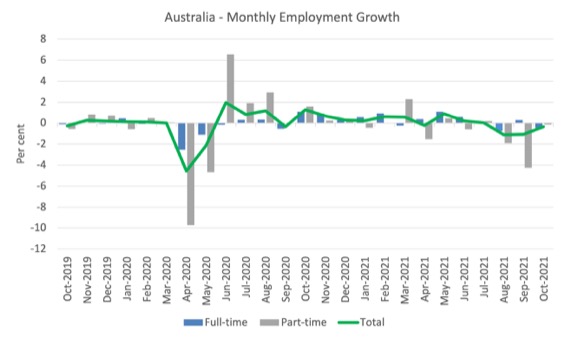
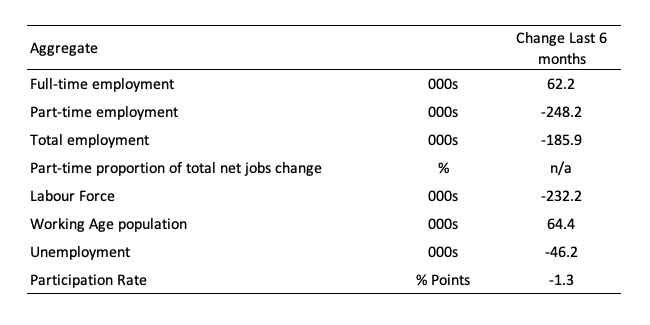
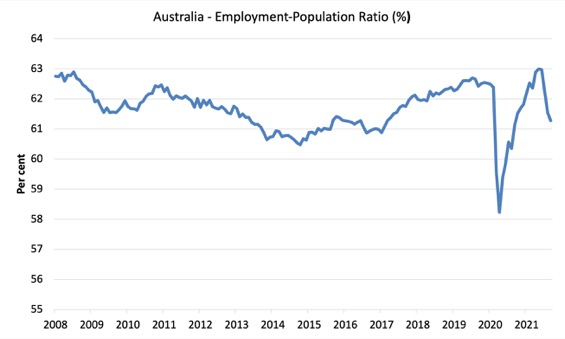
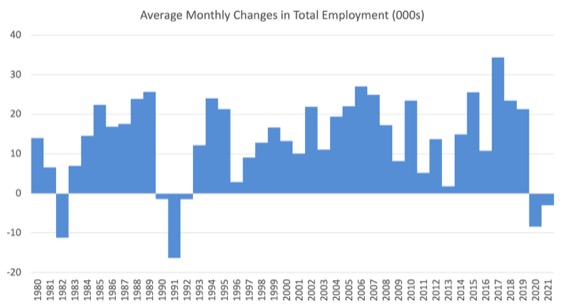
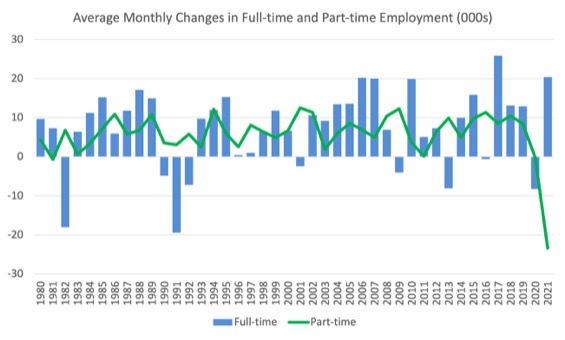
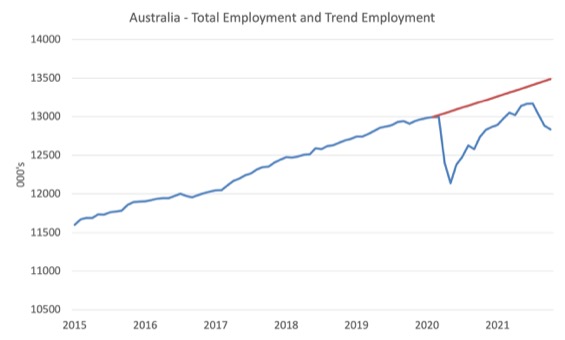
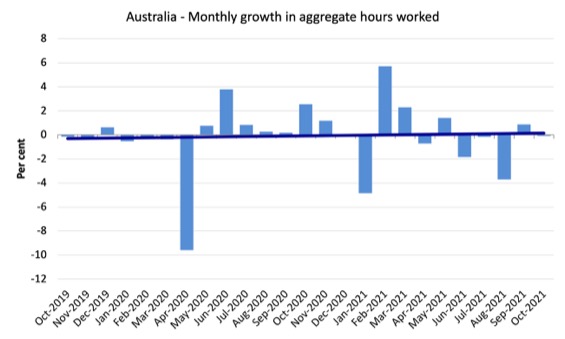
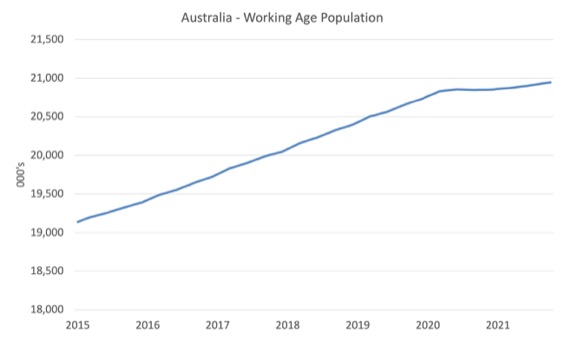
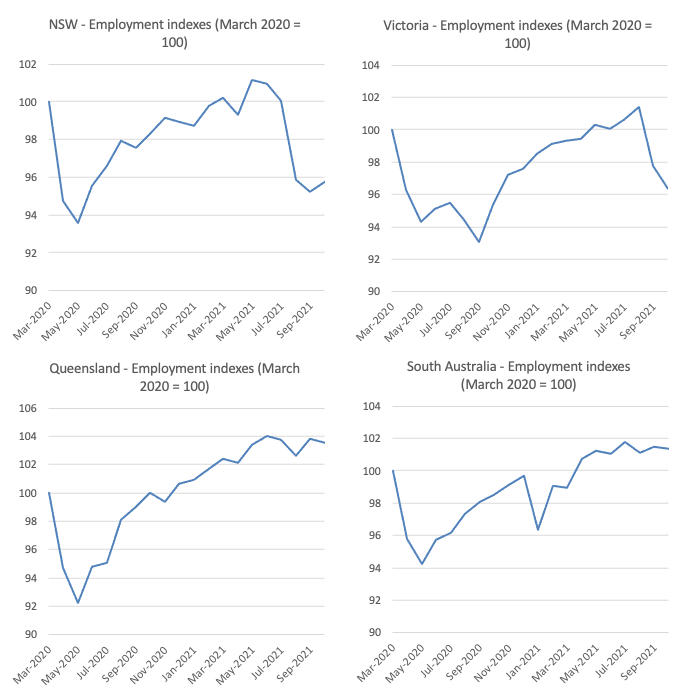
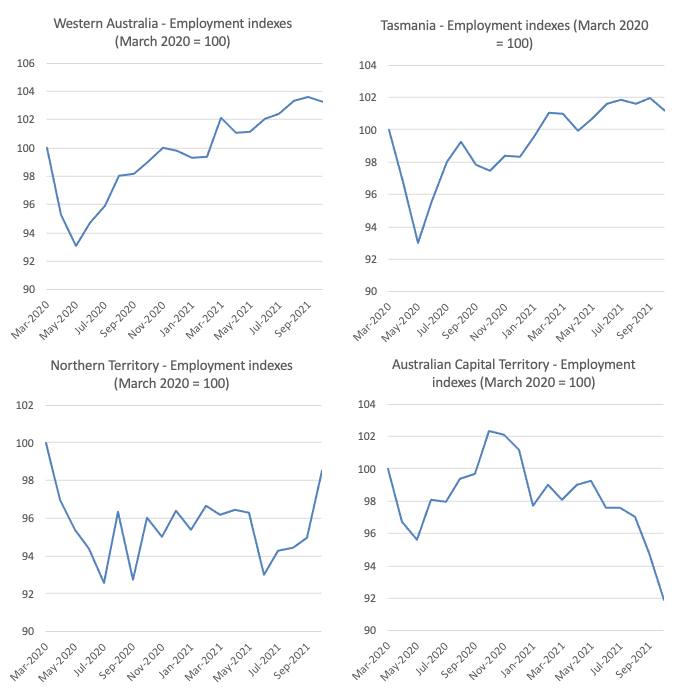
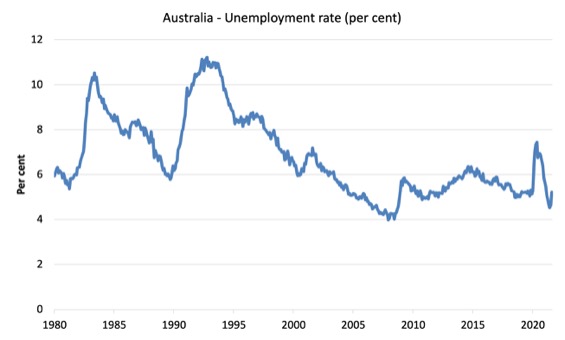
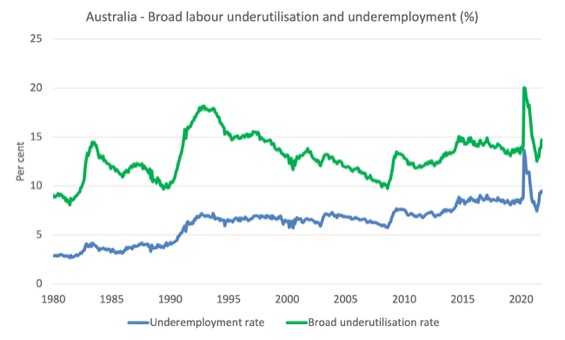
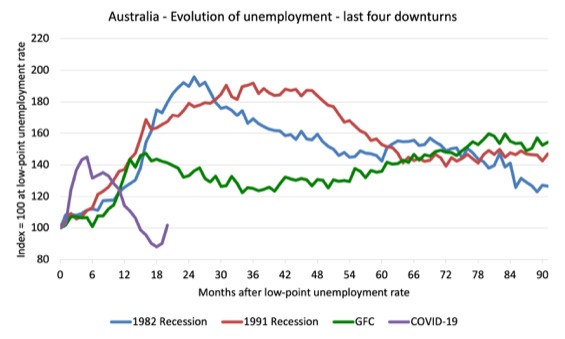
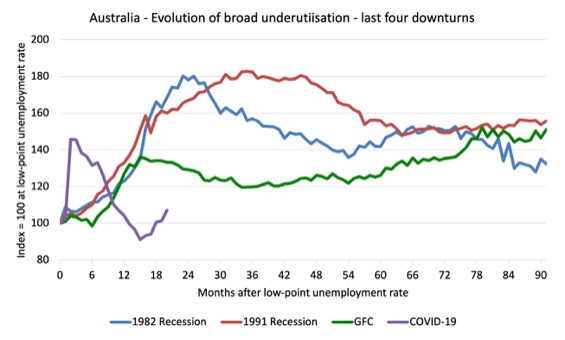
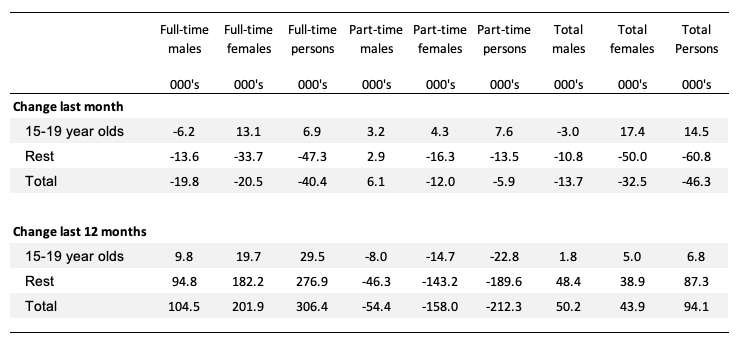
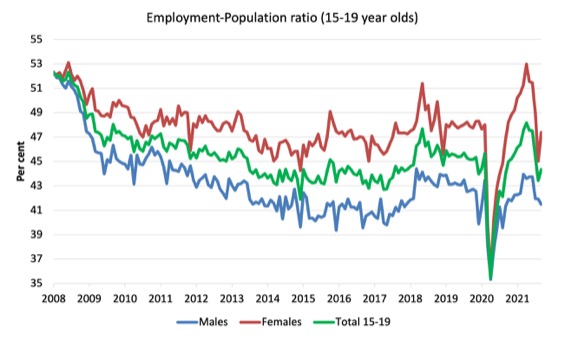
Observations based on graphs:
On Graph: “Australia – Evolution of Unemployment – last four downturns”, it shows that the current unemployment situation is a different phenomenon/and distribution compared to the last 3 recessions in terms of: severity and length.
On the Graph: “Australia Working Age Population”, and as bill pointed out – the Population Slowdown, or in my perception, as the Baby-boomer generation reaches its retirement age, it might be normal to see this graph and see it coincides with the Graph “Australia – Total Employment and Trend Employment”, which looks similar.
So, I see no alarm there – the Covid-19 and economic situations might not be so bad after all (could be due to e-commerce and WFH partly).
However, as we know, due to the pandemic, the usual level of employment, global trade and tourism will take times to recover, it remains crucial that governments continue to look into domestic sector as a mean of growth, and that depends on fiscal stimulus with extended timeframe (one of Bill’s conclusions).
For this, I further see that it should not be so much just any stimulus but a green spending package to restructure economy. I see this as an opportunity to transform our fossil fuel economy, processes and the likes into greener, circular and sustainable. For all sectors too.
This should be the target of spending (while observing Covid-19 related safety precautions of course.
I also see this strategy will be useful for many, if not all countries, as we are in the same boat.
But how each country/politicians come to understand this and especially the MMT framework is becoming more crucial by the day, to generate the capacity.
Otherwise, the neoliberal mantras will make sure that misery/austerity is the answer, as we have seen it in Greece, the EU, the UK as well as other countries around the world after the GFC.
Thank you very much for your analysis, Bill.
Do you have an estimate of the number of hidden unemployed in Australia today? My understanding of the term hidden unemployed is that it describes a person who is not actively seeking a job but they would accept a suitable job if it were offered to them now.